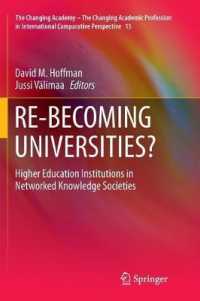Full Description
During the past two decades, several changes have transformed core practices of teacher educators. One of the most salient changes pertains to dramatic shifts in school demographics. In practically every state in the United States, primary, elementary, middle, and high schools are experiencing expanding enrollments of students whose primary language is not English. Recent demographic data show that linguistically and culturally diverse students constitute an increasingly strong presence in our schools and communities. There are approximately 5 million ELs in the U.S., and this number is on the rise.It is estimated that two-thirds of these students are in at least one course taught by general education teachers. Growth in K-12 EL enrollment has skyrocketed in the past 20 years. One in 20 public K-12 students was an EL in 1990. In 2008, it was one in nine. Projections suggest that in 20 years it will be one in four.
The content of the book integrates new and emerging research and policy insights that inform effective teaching of ELs across the disciplines. The chapters in this book will in ways to give teachers the tools they need to improve the quality of instruction in classrooms with ELs in grades K-12 both in the United States and around the world.
In this book a select group of contributors address a variety of topics to enhance ELs language and literacy skills, as well increase their reading comprehension abilities across the curriculum. Chapter topics include reading and writing instruction focusing on the Common Core standards, classroom-based assessment, literacy-based mathematics instruction, literacy instruction using current technologies that include digital literacies and social media, as well as context-embedded vocabulary development using art.
Contents
Introduction: Research, Policy, and Practice Insights to Support the Teaching of English Learners in Mainstream Classrooms
Kouider Mokhtari and Myra Daniel
Part I: Supporting English Learners' language and Literacy Development Across the Disciplines
Chapter 1. Enhancing English Learners' Access to Disciplinary Texts Through Close Reading Practices
Zhihui Fang, Suzanne C. Chapman, University of Florida
Chapter 2. High Expectations: Increasing Productivity and Complexity in English Learner (EL) Writing
Kathleen A. J. Mohr, Sylvia Read, Alayne Leavitt, Utah State University
Chapter 3. A Middle School Mathematics Workshop for Multilingual Classrooms: Lessons Learned From A Highly Effective Teacher
Mayra C. Daniel, Northern Illinois University, Billy Hueramo, Littlejohn Elementary School
Chapter 4. Using Art and Literature to Enhance Critical Thinking and Vocabulary Development for English Learners
Chris Carger, Northern Illinois University
Chapter 5. The Case for Young Adult Literature: Using Narratives in the EL Classroom
Melanie D. Koss, Northern Illinois University
Part II: Using Assessment Data To Document Student Performance And Inform Instruction
Chapter 6. Using Metacognitive Assessments to Identify Students' Reading Comprehension Strengths and Needs
Kouider Mokhtari, The University of Texas at Tyler
Chapter 7. Using Classroom Assessment of Language Levels (CALL) to Address Common Core Standards-based Instruction with English Learners, K-8
Paul Boyd-Batstone, California State University
Part III: Supporting Students Literacy Development In Digital Spaces
Chapter 8. Digital Literacies for English Learners: Theory and Practice
Ian O'Byrne, University of New Haven, Martha Castañeda, Miami University
Chapter 9. Integrating Social Media into ELA Curriculum: Towards English Learners' Academic Literacy Development
Dong-shin Shin, Northern Illinois University
Part VI: Using Key Understandings About Language and Literacy to Support Instruction for English Learners
Chapter 10. Insights Gleaned from Research Syntheses About Teaching English Learners
John Evar Strid, Northern Illinois University
Chapter 11. Addressing the Reading Comprehension Challenges of English Learners in K-12 Classrooms Using Research-Based Practices
Fabiola P. Ehlers-Zavala, Colorado State University
Chapter 12. Socrates Returns to the Classroom
Joan Wink, California State University, Kerry Britton, Hill City Middle School,
Dee Hawksworth, Oakdale Junior High School, Tammy Mc Morrow, Indian Creek Elementary School, Debra Schneider, Tracy Unified School District, Chyllis Scott, University of Nevada, Ruthie Wienk, South Dakota State University, Dawn Wink, Santa Fe Community College
Chapter 13. Mainstream Literacy Teachers in Multilingual and Transnational Learning Communities: Making a Case for Transliteracy
David Schwarzer, Montclair State University







